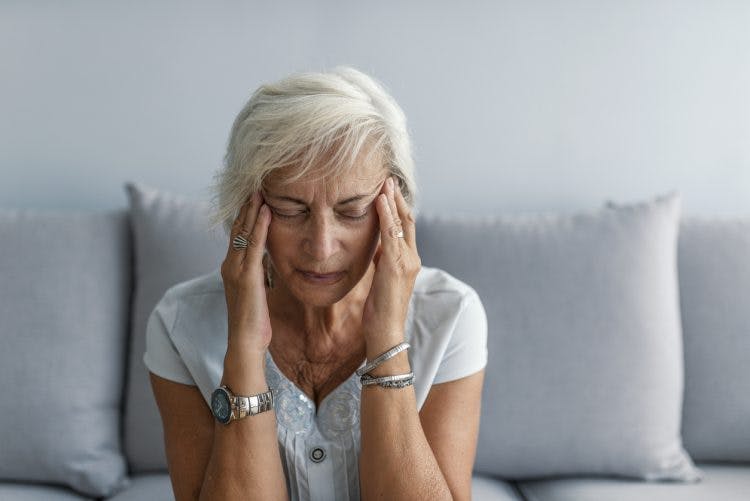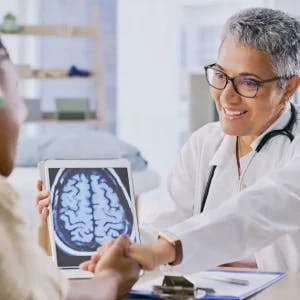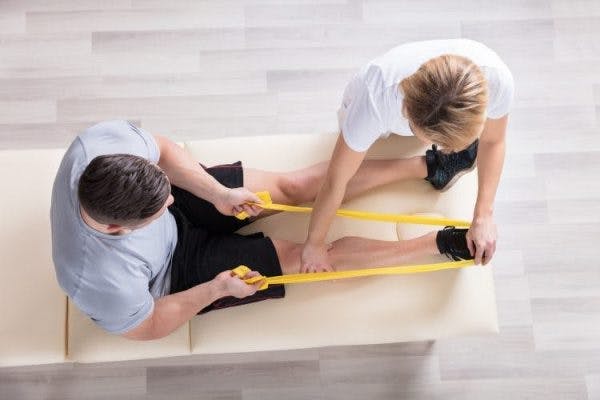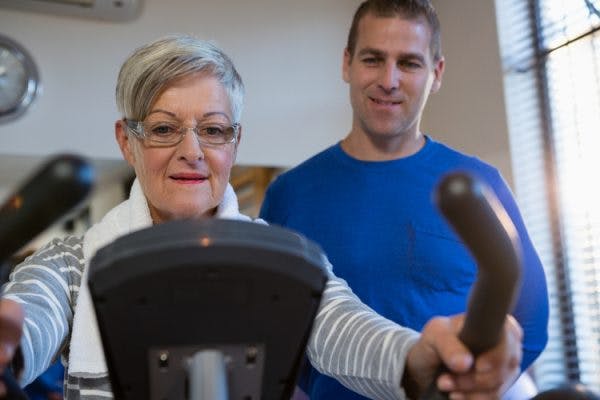Every year, over 795,000 strokes occur in the United States. This makes recognizing the early warnings signs of a stroke crucial. Knowing the stroke warning signs and how to seek prompt medical attention can save a life!
A common saying is time lost is brain lost. Immediate medical care is essential for stabilizing the damage and minimizing the secondary effects of a stroke.
In this article, we will outline common early warning signs of stroke so you know what to look for. In addition, we will describe how current public health campaigns have improved our recognition of stroke warning signs. Finally, we will look at major stroke risk factors as well as the stroke preventative measures to keep you and your loved ones safe!
Use the links below to jump directly to any section:
- What is a stroke?
- Act F.A.S.T. to spot a stroke
- Other early warning signs of stroke
- Importance of stroke awareness campaigns
- Stroke risk factors and prevention
What is a Stroke?
A stroke occurs when an artery in the brain becomes either clogged by a blood clot (ischemic stroke) or bursts (hemorrhagic stroke). This leads to insufficient blood supply in associated areas of the brain, depriving the cells of oxygen and other essential nutrients needed to survive. As a result, the cells begin to become damaged and potentially die, resulting in permanent brain damage.
Individuals may also experience stroke-like symptoms when they have a transient ischemic attack (TIA), also known as a “mini stroke.” Although TIAs generally resolve themselves, they are often major warning signs that a full stroke may occur in the future. In fact, individuals have a 10-18% greater stroke risk throughout the first 3 months after experiencing a TIA..
To minimize the damage caused by a TIA or stroke, immediate medical attention is needed to stabilize the brain and help restore blood flow to the affected area. Early treatment is critical, as each minute of delay may result in further brain damage.
For those having an ischemic stroke, a medication called tPA is frequently used to dissolve the blood clot and allow nutrients to once again return to the affected areas of the brain. This limits the damage from the stroke, resulting in better overall functional outcomes.
However, effective use of tPA is only possible within a few hours of the onset of stroke symptoms. This makes time essential, which is why the saying “time is brain exists”.
Similarly, those who are having a hemorrhagic stroke also benefit from immediate medical attention to control the bleed through medications (especially for those on blood thinners) or surgery.
The “F.A.S.T.” Acronym for Spotting a Stroke
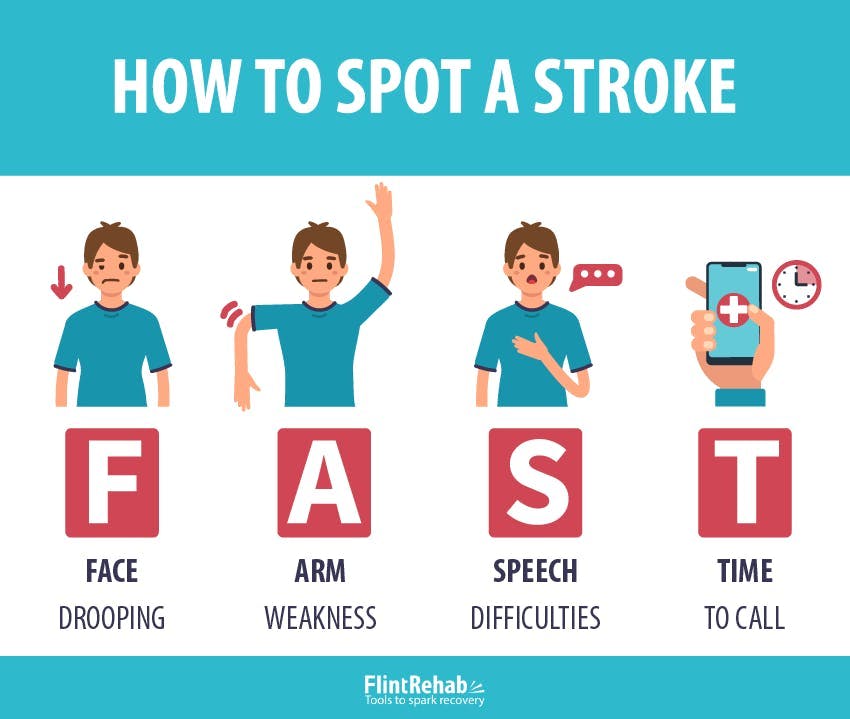
There are three major signs that often occur when someone is having a stroke. Individuals may exhibit one, two, or all three of these signs. The American Stroke Association and the CDC both recommend using the phrase “Act F.A.S.T.” to help remember these early warning signs of stroke. The acronym F.A.S.T. stands for:
- Face: Ask the individual to smile. Facial drooping or numbness, especially on just one side of the face, may indicate a stroke.
- Arms: Ask the individual to raise their arms. Arm weakness or numbness may also signify a stroke. Check if both arms can raise to the same height, and ensure one arm is not drifting downward.
- Speech: Ask the individual to repeat a simple sentence. Slurred speech or difficulty responding may also be signs of stroke.
- Time: When one or more of these early warning signs of stroke are present, medical attention is required immediately. Call 9-1-1, and note the time when symptoms first appeared.
Since early stroke identification is essential for optimal outcomes, remembering to act F.A.S.T. can be extremely beneficial. If any of these early warning signs are seen, it is essential to use 9-1-1 to call for an ambulance.
Using an ambulance can allow medical professionals to begin the assessment and treatment process on the way to the hospital. This saves valuable time that otherwise would be wasted riding in a car. It is crucial to note that individuals should never try to drive themselves to the hospital if they suspect they may be having a stroke.
Other Early Warning Signs of Stroke
While the symptoms above are the most common signs of stroke, other early warning signs of stroke may occur. These include:
- Dizziness: When dizziness occurs suddenly without an obvious cause, it can foreshadow a stroke – especially a cerebellar stroke.
- Trouble walking: Individuals having a stroke may experience sudden walking difficulties due to weakness, numbness, incoordination or balance issues.
- Numbness and/or weakness: Numbness and/or weakness due to stroke may occur on just one side of the body, or may affect multiple areas.
- Vertigo: About 6% of emergency room admissions due to vertigo are actually cases of acute stroke.
- Confusion: Sudden onset of confusion can be a symptom of stroke.
- Sudden vision problems: Trouble seeing in one or both eyes could indicate a stroke near the vision center of the brain.
- Severe headache: Particularly common with subarachnoid hemorrhages, the sudden onset of a severe headache could actually be caused by a stroke.
If someone is demonstrating any of these symptoms, seek emergency help immediately. Although it may not seem extremely serious, it is always better to be safe than sorry.
Additionally, if doctors seem to have no other explanations for these sudden onset symptoms, ask for an MRI or CT scan to help identify whether a stroke may be occurring.
MRIs tend to be more effective at diagnosing ischemic stroke, while CT scans are usually more sensitive to detecting hemorrhagic strokes.The Cincinnati Stroke Scale can also provide a quick, reliable method that helps healthcare professionals and even laypersons identify stroke symptoms and act promptly.
Importance of Stroke Awareness Campaigns
Stroke is a leading cause of death and disability worldwide. To improve stroke outcomes, many countries have developed public health campaigns dedicated to increasing awareness of the early warning signs of stroke. These campaigns, many of which focused on the phrase “Act F.A.S.T.” have targeted both adults and children alike to improve early stroke recognition.
A 2022 systematic review on the effectiveness of public health campaigns targeting stroke recognition found that these types of campaigns can significantly boost awareness. In fact, following public health campaigns, there was approximately a 20% improvement in stroke symptom recognition and intention to call for emergency care.
Studies have also indicated that educating children about the early warning signs of stroke can have an impact on stroke recognition. For example, using the FAST Heroes education campaign, students ages 5-9 in 14 different countries participated in a stroke awareness program for an hour per week over a 5-week period.
Before the program, 55% of the children’s parents could identify the symptoms noted in the F.A.S.T. acronym. Immediately following the program, 79% of parents could identify symptoms, and by 6 months after the program, 94% were able to identify all three symptoms. This demonstrates that implementing public health campaigns in schools can also be an effective way to boost awareness, even among adults.
Although public awareness of the early warning signs of stroke is improving, there is still a gap in knowledge. According to the 2017 National Health Interview Survey, 67.5% of those surveyed in the US were aware of five of the most common stroke symptoms and the need to call 9-1-1 upon recognition of these symptoms.
This leaves significant room for improvement. Sharing “Act F.A.S.T.” or other stroke awareness campaigns can improve stroke recognition, promoting early stroke treatment and improved recovery outcomes.
Improving Cross-Cultural Awareness of Stroke Warning Signs
While some have tried to translate “Act F.A.S.T.” to other languages to improve early stroke recognition, this is not always very effective. A related acronym has been developed for Spanish speakers, RÁPIDO. Also meaning fast, RÁPIDO stands for:
- Rostro caído (drooping face)
- Alteración del equilibrio (balance disturbance)
- Pérdida de fuerza (loss of strength)
- Impedimento visual (visual impairment)
- Dificultad para hablar (difficulty speaking)
- Obtenga ayuda rápido (get help quickly)
In the United States, those who are Hispanic tend to be less aware of stroke symptoms than White or Black Americans. Increasing early stroke identification is especially important for the Hispanic population, as their risk of stroke is predicted to increase in the following years.
Stroke Risk Factors and Prevention
Although stroke is commonly seen in the US, up to 80% of strokes are preventable. By adopting a healthier lifestyle, many major risk factors for stroke can be effectively managed.
Major risk factors of stroke include:
- Hypertension (high blood pressure)
- Smoking
- High cholesterol
- Heart disease
- Diabetes
- Heavy alcohol use
- Transient ischemic attack (TIA)
- Prior stroke
- Obesity
- High levels of stress
Additionally, the incidence of stroke increases with age. It is suggested that the risk of having a stroke nearly doubles each decade after age 55. By making lifestyle modifications such as adopting a healthy diet, increasing physical activity, quitting smoking, and maintaining a healthy weight, individuals can significantly reduce their risk of having a stroke.
Understanding the Warning Signs of Stroke
Stroke is the 5th leading cause of death in the US. Fortunately, it is also one of the most preventable. The number of stroke-related deaths can be significantly reduced by educating others to recognize the early warning signs. Remember to act F.A.S.T. and seek immediate medical attention to minimize brain damage if any potential signs of stroke are seen.
Quickly identifying the early warning signs of stroke such as facial drooping, arm weakness, and/or speech difficulties can allow individuals to seek emergency medical treatment promptly. This can promote better stroke outcomes and possibly even save a life.
If you believe you may be experiencing the symptoms of a stroke, do not take a chance. Dial 911 and get emergency help immediately.

